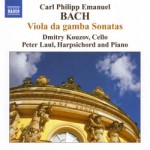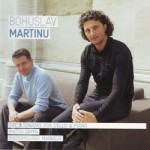Column Name
Title
Carl Philipp Emanuel Bach: Viola da gamba Sonatas. Dmitry Kouzov, cello; Peter Laul, harpsichord and piano. (Naxos 8.570740)
Body
In his excellent notes for this release, longtime Naxos writer Keith Anderson quotes a scholar in the 1770s who dismissed the viola da gamba: “The tones ... are radically so crude and nasal, that nothing but the greatest skill and refinement can make them bearable: a human voice of the same quality would be intolerable.” It would be interesting to get reactions to that comment from cellist Dmitry Kouzov and harpsichordist Peter Laul, collaborators since 1993, since there is no doubt that their refined and vigorous work here makes a joyful listening experience. Performing C.P.E. Bach’s sonatas for viola da gamba on a modern cello, Kouzov, who earned an Artist Diploma at Juilliard where he studied with Joel Krosnick and now serves as his assistant, shows the fruits of his partnership with Laul. Their rapport is immediately apparent in the opening of the lilting Sonata in C Major, Wq. 136, H. 558, the first of a pair written during the time of the composer’s tenure as court harpsichordist to Frederick the Great.
The two sonatas share a winsome charm, and Kouzov and Laul unearth all the poetry available, with the cellist keeping vibrato to the barest minimum. Feeling is everywhere: both sonatas end with “arioso” movements of heartbreaking tenderness, which engineer Alexei Barashkin, recording the duo in the St. Petersburg State Capella Recording Studio in Russia, has captured with appealing naturalness. Small details abound: In the second movement of the D Major Sonata, Wq. 137, H. 559, marked Allegro di molto, the cellist’s fingertips are lightly audible in the most pleasant way. In the final movement, some groaning double-stops evoking the solemnity of the Gregorian Dies Irae theme alternate with a plaintive melody, and Kouzov deploys a slightly rough tone for the former, a sweetly ingenuous one for the latter, with Laul in rock-steady accompaniment. This second arioso might be the highlight of the entire CD, and as it winds to its close, both musicians find beauty in the composer’s laconic melodic invention.
Laul switches to piano for the Trio Sonata in G Minor, Wq. 88, H. 510, its Allegro marching off smartly and showing both players’ agility in the faster passages. After a haunting slow movement, the vigorous, gleeful Allegro assai is a marvel of precision.
Bohuslav Martinu: The Three Sonatas for Cello and Piano. Mattia Zappa, cello; Massimiliano Mainolfi, piano. (Claves 50-2803)
Czech composer Bohuslav Martinu’s Cello Sonata No. 1 dates from 1939—one year after his searing Double Concerto, a masterpiece reflecting his homeland's rising anguish prior to World War II—and the sonata is marked by similar emotion. Pianist Massimiliano Mainolfi sets the mood in the sober opening before cellist Mattia Zappa (who earned an Advanced Certificate from Juilliard in 1995) joins him in tense footsteps, while the mellow, fine-grained recording by Deutschlandradio (on Claves) shows off the artists’ mournful tone. After an impassioned Lento, the nervous finale has high spirits but a decidedly dark underbelly, and here these musicians’ expertise comes to the fore, their keen attention to light and shade only underlining the composer’s anxious mood.
Although the Second Sonata (1941) seems more extroverted, with rhythmic motifs coming center stage, there is still a pervasive sadness. A central, desolate Largo might be the work’s spiritual heart, and Zappa and Mainolfi deliver its quiet power with meticulous dynamic shading. But in the outer movements, the virtuosity required is irresistible, especially in the opening, where the cellist sails over Mainolfi’s strongly articulated rhythmic core. The hard-driving finale displays the composer's love of strongly accented meters, with the result somehow more than a little sinister.
Ten years passed before the last sonata appeared, in 1952, and here Martinu (1890-1959) seems to have reached a plateau of peaceful acceptance, whether of his exile from Czechoslovakia or of his life in general. With a more fluid approach to form, he seems in a sunnier, more lyrical mood, echoed by Zappa and Mainolfi in a playful spirit. The inventive Andante stealthily mines Czech melodies for every last bit of soul, and the final measures are particularly moving. To close this major addition to the Martinu canon, the two artists intertwine in a high-spirited Allegro, marked by a particularly sparkling piano line.






